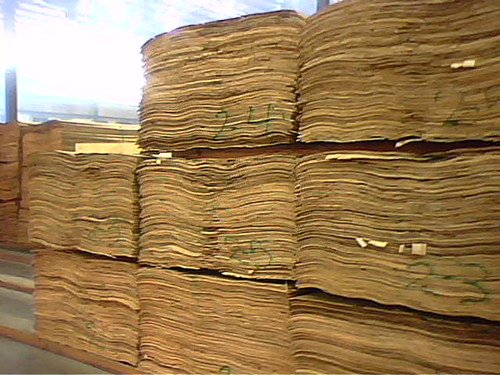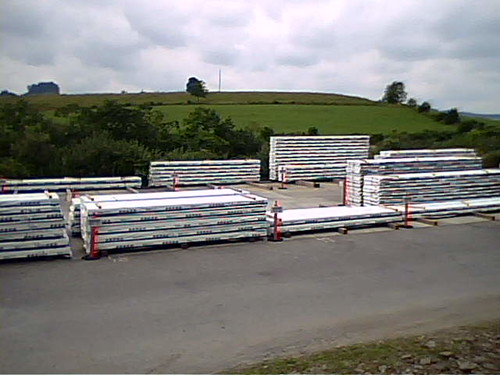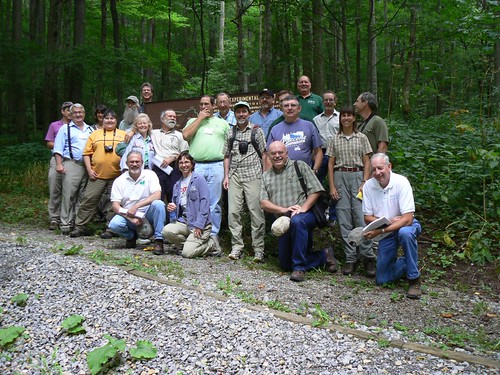Normally you wouldn't think of Google Maps Street View as a helpful tool for forestry. Most of the scenes are concentrated in urban areas, where the people are. However, Google has been sending its cars out from the city centers to the rural areas. This can provide a good opportunity to illustrate forestry operations in an embedded map view.
For example, this scene shows the aftermath of a pine plantation removal operation in the Waynesboro Watershed in Hamiltonban Township, PA. The site has been treated with herbicides to remove invasive plants and shrubs. Most of it has been replanted, although none of the seedlings are yet visible.
As with all Google Maps views this one can be opened to its own screen for viewing or manipulated in its own window.
Further along the same road a deer fence was put in place to protect hardwood regneration in a stand where diseased hemlock and overtopped trees were removed several years previously. Use the map controls to pan up and see the canopy opening. (Click on the map and move the view around.)
This last view shows the PA Bureau of Forestry Ralph Brock Seed Orchard along Rte 233. The pines here have been topped to concentrate cone production on the lower branches. This treatment mystifies people who drive by until the purpose is explained to them!
Thursday, October 15, 2009
Tuesday, August 11, 2009
Glenville State College Forest
The teaching forest for the Glenville State College Forest is located a short ways from campus. There are some unique problems involved in managing the forest. High rates of deer browsing, the high slopes, and sharing the roads with the gas well at the top of the forest are all challenges that have to be considered.

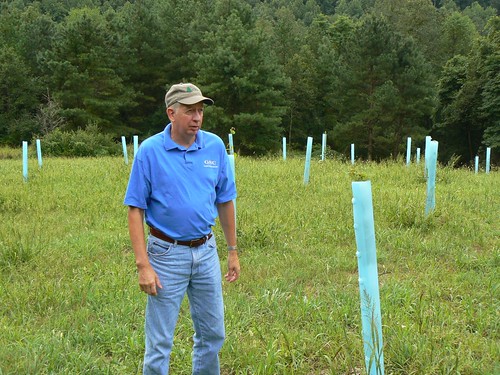

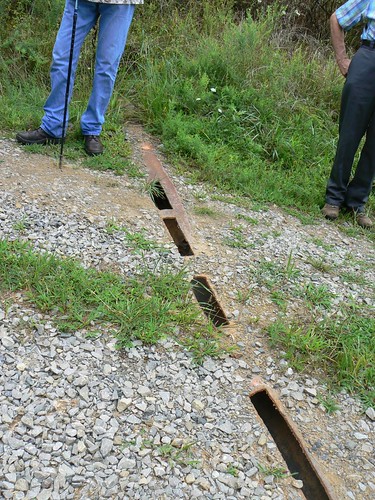
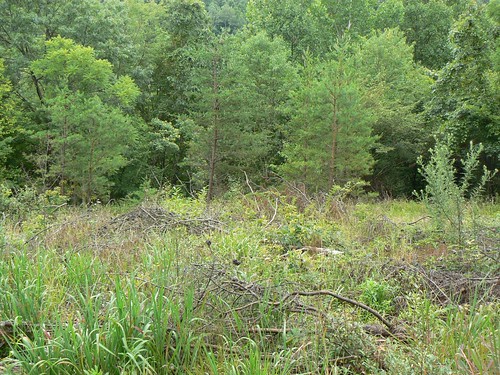

Rick Sypolt describes the hybrid chestnut trials. The goal is to have 15/16's American chestnuts that are blight-resistant.

Road maintenance is critical when slopes are this steep. The gas well company contributes to the cost of materials. The College keeps the road graded and maintained.



More pictures from the Glenville State College Forest visit:
Monday, August 10, 2009
iLevel Veneer Technology Plant
A tour of Weyerhaeuser's iLevel Veneer Technology Plant in Buckhannon, WV was one of the most interesting stops on the CEFTS 2009 meeting. At this plant yellow poplar veneer is used to manufacture beams using the Microlam and Paralam processes. During the fabrication process nothing is wasted as the beams are created.
Safety was a main concern for the tour. Harry Hutchins is decked out in the full gear of hardhat with radio, vest, and safety glasses. The radios were a great way to hear information from our guides over the sound of the mill.
Stacks of freshly peeled yellow poplar veneer
Newly fabricated microlam beams

Finished product ready for shipping:
Thanks to Brian Wilson, Mark Shreve, Don Grant, and John Holstine for the excellent tour.
Saturday, August 8, 2009
CEFTS Meeting at Glenville State College
The 2009 CEFTS meeting (August 4-9) has just wrapped up. The folks at Glenville State planned an excellent meeting.
In field trips during the meeting we visited the:
- Glenville State College University Forest
- Weyerhaeuser iLevel Veneer Technology Plant in Buckhannon
- Fernow Experimental Forest on the Monongehela National Forest
The following map shows the areas visited during the field trips.
View CEFTS 2009 Meeting Locations in a larger map
Thursday, June 4, 2009
GSC PART OF EFFORT TO RESTORE THE AMERICAN CHESTNUT
Glenville, WV—With the planting of over one hundred trees in two separate orchards, Glenville State College has joined the fight to restore the majestic American chestnut tree to West Virginia forests.
Once dominant in eastern forests, the American chestnut, which accounted for up to twenty-five percent of all hardwood trees, was pushed to the brink of extinction by perhaps the deadliest plant blight ever. The blight which attacked and destroyed the American chestnut was brought in from Asia on imported species of trees. First discovered in 1904, the blight spread quickly through forests from Maine to Florida. By 1950 the mature American chestnut forest was all but dead. Individual trees, and a few stands are all that remain.
Today there are promising prospects for the restoration of the American chestnut due in a major part to the efforts of The American Chestnut Foundation (TACF). Established in 1983, this non-profit organization is breeding and planting blight resistant strains of chestnut trees. The Asian species of chestnuts are resistant to the blight. By cross-breeding these species with American chestnuts, TACF hopes to develop an American chestnut that will be resistant to the blight.
On Friday, May 15th faculty members from the Glenville State College Land Resources Department were joined by Dr. Bob Paris, a plant geneticist with The American Chestnut Foundation, for the planting of the first chestnut orchard in West Virginia. Over one hundred seedlings donated by TACF were planted in a field on property used by the GSC Land Resources Department. The orchard includes a variety of chestnut strains including: 100% American chestnut , 75% American chestnut and 25% Chinese chestnut, 87.5 % American chestnut and 12.5% Chinese Chestnut, 15/16 American chestnut and 1/16 Chinese chestnut. “This orchard at Glenville State College is our first in West Virginia. It will be used for testing and research of The American Chestnut Foundation’s breeding program. We hope it will help increase public awareness of the effort to restore the American chestnut,” said Dr. Bob Paris. TACF will be developing similar orchards in other locations including reclaimed surface mine sites.
A second orchard with ten chestnut seedlings was planted next to the GSC greenhouse near Eberle Hall. This orchard will be utilized as a breeding orchard for making crosses that will be adapted to this region and be blight resistant.
“These orchards will provide our GSC students with hands-on experience in tree genetics, greenhouse work, pruning, and propagation. It will also serve as a valuable community service project and help to build a better appreciation of the American chestnut,” said Rick Sypolt, GSC Professor of Forestry and Land Surveying and Chair of the Department of Land Resources.
To learn more about the American chestnut visit www.chestnut@acf.org. For more information about the GSC chestnut orchards contact Rick Sypolt at (304) 462 -7361 ext.6371.
 GSC Professor of Forestry and Land Surveying (left) and TACF Geneticist Bob Paris place plastic tube around chestnut seedling to protect it from hungry wildlife.
GSC Professor of Forestry and Land Surveying (left) and TACF Geneticist Bob Paris place plastic tube around chestnut seedling to protect it from hungry wildlife.
 GSC Instructor of Land Surveying Rick Witte (left) and Dr. Milan Vavrek, associate professor of Natural Resource Management, plant chestnut seedlings.
GSC Instructor of Land Surveying Rick Witte (left) and Dr. Milan Vavrek, associate professor of Natural Resource Management, plant chestnut seedlings.
Once dominant in eastern forests, the American chestnut, which accounted for up to twenty-five percent of all hardwood trees, was pushed to the brink of extinction by perhaps the deadliest plant blight ever. The blight which attacked and destroyed the American chestnut was brought in from Asia on imported species of trees. First discovered in 1904, the blight spread quickly through forests from Maine to Florida. By 1950 the mature American chestnut forest was all but dead. Individual trees, and a few stands are all that remain.
Today there are promising prospects for the restoration of the American chestnut due in a major part to the efforts of The American Chestnut Foundation (TACF). Established in 1983, this non-profit organization is breeding and planting blight resistant strains of chestnut trees. The Asian species of chestnuts are resistant to the blight. By cross-breeding these species with American chestnuts, TACF hopes to develop an American chestnut that will be resistant to the blight.
On Friday, May 15th faculty members from the Glenville State College Land Resources Department were joined by Dr. Bob Paris, a plant geneticist with The American Chestnut Foundation, for the planting of the first chestnut orchard in West Virginia. Over one hundred seedlings donated by TACF were planted in a field on property used by the GSC Land Resources Department. The orchard includes a variety of chestnut strains including: 100% American chestnut , 75% American chestnut and 25% Chinese chestnut, 87.5 % American chestnut and 12.5% Chinese Chestnut, 15/16 American chestnut and 1/16 Chinese chestnut. “This orchard at Glenville State College is our first in West Virginia. It will be used for testing and research of The American Chestnut Foundation’s breeding program. We hope it will help increase public awareness of the effort to restore the American chestnut,” said Dr. Bob Paris. TACF will be developing similar orchards in other locations including reclaimed surface mine sites.
A second orchard with ten chestnut seedlings was planted next to the GSC greenhouse near Eberle Hall. This orchard will be utilized as a breeding orchard for making crosses that will be adapted to this region and be blight resistant.
“These orchards will provide our GSC students with hands-on experience in tree genetics, greenhouse work, pruning, and propagation. It will also serve as a valuable community service project and help to build a better appreciation of the American chestnut,” said Rick Sypolt, GSC Professor of Forestry and Land Surveying and Chair of the Department of Land Resources.
To learn more about the American chestnut visit www.chestnut@acf.org. For more information about the GSC chestnut orchards contact Rick Sypolt at (304) 462 -7361 ext.6371.
 GSC Professor of Forestry and Land Surveying (left) and TACF Geneticist Bob Paris place plastic tube around chestnut seedling to protect it from hungry wildlife.
GSC Professor of Forestry and Land Surveying (left) and TACF Geneticist Bob Paris place plastic tube around chestnut seedling to protect it from hungry wildlife. GSC Instructor of Land Surveying Rick Witte (left) and Dr. Milan Vavrek, associate professor of Natural Resource Management, plant chestnut seedlings.
GSC Instructor of Land Surveying Rick Witte (left) and Dr. Milan Vavrek, associate professor of Natural Resource Management, plant chestnut seedlings.
Subscribe to:
Comments (Atom)

